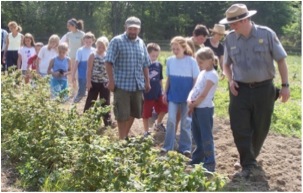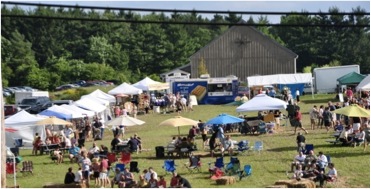Preserving the Harvest: Farming in Parks
Posted: June 2, 2011
Categories: News from Sustain Ontario / Tasting Notes
When I think of the word ‘preservation,’ I often think of things pickled, petrified, mummified: held in a state of suspension, containing life but not living. We preserve things by hiding them or putting them on display in museums like archeological artifacts—their value far removed from their function.
Yet, the definition of preservation, To keep alive or in existence; to keep safe from harm or injury; to keep up; to maintain does not preclude productivity per se. Indeed, in the case of farmland preservation, preserving is dependent on production.
At least that’s how the folks from Cuyahoga Valley’s Countryside Initiative see it. Cuyahoga Valley National Park encompasses 33 000 acres along the Cuyahoga river between Cleveland and Akron, Ohio. Originally established in 1974 as a “Parks to the People” project, a movement to create parkland close to urban populations, the park is responsible for “preserving and protecting for public use and enjoyment, the historic, scenic, natural and recreational values of the Cuyahoga River and adjacent lands” including the rural countryside—a working agricultural landscape. But over the last couple of decades, much of the working agricultural landscape has gone fallow, the houses and barns to decay, and farmers to the city.
Darwin Kelsey of Ohio’s Countryside Conservancy and Darlene Kelbach of the Cuyahoga Valley National Park have been working for the past 10 years to reverse that trend. They see farmers who live and work on-site as an essential element to preserving the character of the rural landscape. So much so, that they are willing to go to great lengths to attract the right stewards. The park offers 60 year leases to farmers who win a request for proposals process that judges applicants on economic and ecological sustainability criteria. The winners of the process get to live in a restored heritage building (the park has invested an average of $475, 000 to make them livable) at 50% fair market value rent in exchange for the extra controls and bureaucracy associated with park life. They also receive anywhere from 5 to 30 acres of land for a percentage of their earnings (10% of gross). This means that the park shares the farmers’ risk—if the farmer makes money, the park receives rent. While farmers do not own the land, they own the business and any improvements they make and can sell this as equity if they ever want to leave. While a 60 year lease is not equivalent to ownership, the long-term tenureship allows farmers to plan for the future and invest in their soil. The initiative is also excited to see farms remain in the family; family members have an extra leg up on the RFP process at the end of 60 years if they have been involved in the farm business.
Darwin and Darlene shared some of their challenges as well as their successes with a room full of conservation authority, farmer and NGO representatives this past Tuesday, May 17th at an event hosted by FarmStart, an organization dedicated to supporting new farmers to develop economically viable, locally based, and ecological agricultural enterprises. With 45 acres leased on Toronto and Region Conservation Authority (TRCA) land in Brampton for the ‘incubation’ of new farmers and more being established in Rouge Park, FarmStart is a fitting host. Some other attendees included Just Food, an organization out of Ottawa looking to replicate the incubation farm model on National Capital Commission property; Ontario Farmland Trust, an organization set up to facilitate the preservation of farmland through easements and the donation of lands; Toronto District School Board Outdoor Education representative, Deanna Coop, who is involved in establishing an educational farm on TRCA land at Albion Hills; Seldom Seen Seldom Heard, a family-owned organic farm with a conservation easement on the Oak Ridges Moraine; and many others. While city support for community gardens in parks is widely accepted, the idea of private entrepreneurs operating on publicly-owned land is still a developing notion for many Ontarians. Logging and hunting have been part of our Northern parks for at least half a decade and conservation authorities have often leased land to cash croppers. However, if we start to look at it from the Cuyahoga perspective, the types of farmers that preserve the character of a rural landscape, maintain barns and farmhouses, are the kinds of farmers that are endangered and need a hand getting started.
Are we creating a museum of farming? Some farmers believe that any subsidy, even the tax rebate for the meager $7000 farm income, skews statistics of farmer viability and creates a catch 22 wherein farmers are viable because of subsidies and off-farm income, impacting their scale and prices. Others, like Cuyahoga, believe that small-scale farmers selling to direct markets are the only farmers actually making a living in the current economic climate, they just need an entry-point; these farmers offer services that have long been underappreciated and it is time that we start to value them, before they disappear.



